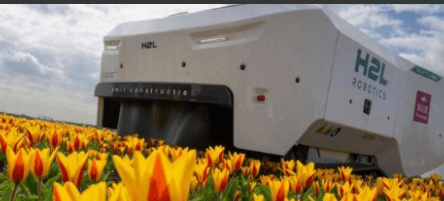“Blossoming Technology: The Role of Robots in Protecting Dutch Tulip Fields”

Theo tirelessly fulfills his duties Dutch Tulip Fields on weekdays, weekends, and nights, displaying remarkable resilience despite the grueling tasks that would typically strain the back of an ordinary farmhand. His commitment involves meticulously inspecting Dutch tulip fields for signs of disease, a job that demands countless hours of labor.
READ: New York Businesses Ordered to Require Masks Indoors or Vaccine Proof
Dutch Tulip Fields
Enter the boxy robot, affectionately named after a retired employee at the WAM Pennings farm along the Dutch North Sea coast. This high-tech marvel represents a new frontier in combating disease within the vibrant springtime landscapes of the bulb fields.
On a breezy spring morning, the robot traverses rows of vibrant yellow and red “goudstuk” tulips, methodically assessing each plant’s health. When necessary, it intervenes by eliminating diseased bulbs to halt the spread of the tulip-breaking virus. Subsequently, these afflicted bulbs are meticulously separated from the healthy ones in a sorting facility after harvest.
The tulip-breaking virus poses a significant threat, inhibiting plant growth and resulting in smaller, weaker flowers. Moreover, it undermines the bulbs themselves, rendering them incapable of blooming.
To address this menace, 45 robots now patrol tulip fields across the Netherlands as farmers gear up for peak season, attracting tourists from far and wide to behold the kaleidoscope of colors. Previously, such tasks were undertaken by human “sickness spotters,” according to Allan Visser, a third-generation tulip farmer embracing the use of these robots for the second consecutive growing season.
Despite the hefty price tag of 185,000 euros ($200,000), Visser emphasizes the invaluable role the robot plays in preserving crop health, contrasting it with the allure of a sports car. This technological investment reflects a shifting landscape where fewer individuals possess the expertise to identify diseased tulips.
While the robot’s pace may be leisurely at one kilometer per hour (0.6 mph), its capabilities are nothing short of remarkable. Equipped with cameras and powered by artificial intelligence, it meticulously scans tulips, identifying symptoms of disease with precision. Erik de Jong of H2L Robotics, the company behind these robots, underscores the fusion of farmer expertise with AI technology, enabling precise identification and eradication of diseased flowers.
For Theo van der Voort, the retired employee honored with the robot’s namesake, witnessing its capabilities is nothing short of awe-inspiring. Having spent 52 years diligently hunting for sick flowers, he marvels at the robot’s proficiency, noting that it observes the fields with the same keen eye as he once did.




